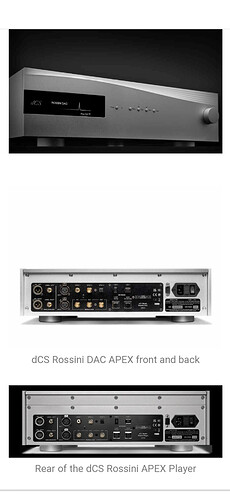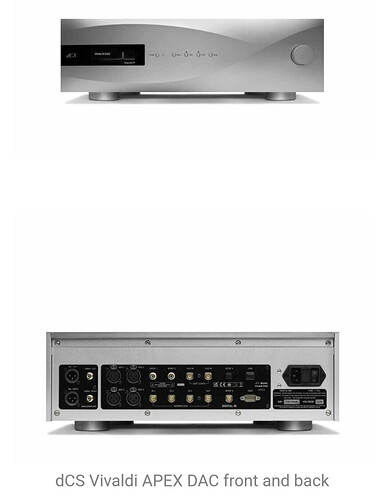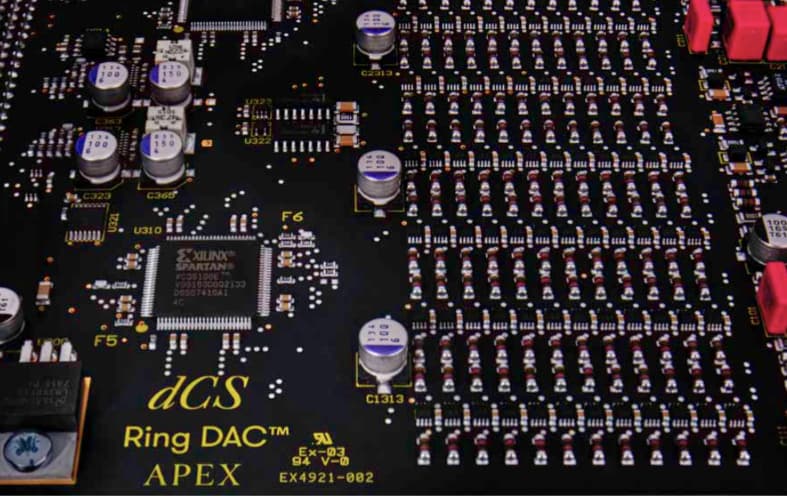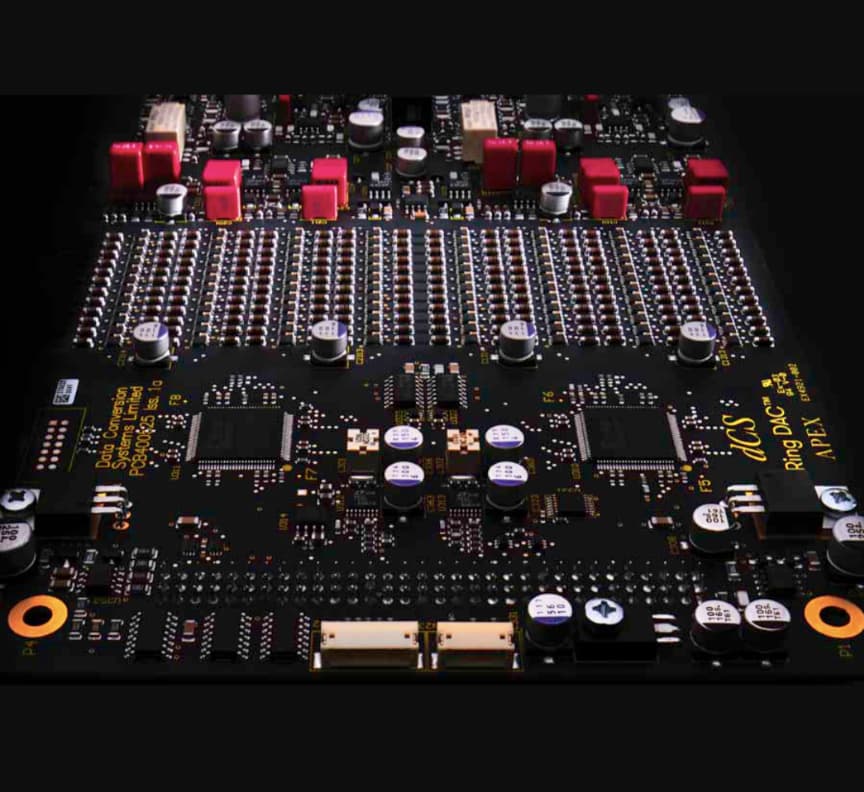I think you can better contact your own dealer about the price of the Vivaldi Apex DAC upgrade. The price I was given is for The Netherlands. But I expect the price is the same for Rossini and Vivaldi, since it is the same hardware upgrade.
I have a new Rossini Apex on order here in the UK (along with a Vivaldi clock). The Apex is £6,000 more than the original Rossini DAC. No accurate delivery timescales provided yet.
6,000.00 British Pounds = 7,264.51 Euros. So it is cheaper in the UK. Congrats!
Its £6000 plus vat i think
8490€ the upgrade for the Vivaldi (incl VAT) in France through dealer and including shipment.
We are both poor and cheapskates here, relatively speaking! My dealer did say that margins in the UK were being lowered all round, by which I think he meant by dCS, distributor, and retailer. I’d take that with a pinch of salt though. I don’t know enough to compare hi-fi markets in different countries, but I do get the impression that we in the UK are fickle, review driven, and quite spoiled for choice.
Put my deposit down on the Vivaldi upgrade this afternoon. My dealer still believes his tech will be allowed to perform the update. We will see as the process begins.
I’m pretty sure it’s £6000 inc VAT in the UK.
In the US I was quoted $8500 plus tax.
Yes its £6000 total for the uk
Dealer got it wrong, but in his defence it was a good week plus ago he told me this
Called my dealer this morning and got in line(US). As stated nothing is happening till May. As mentioned somewhere US units are being shipped to a service center in Boston. My dealer is covering shipping for all of his customers.
I have had my Rossini DAC for just under 6 months and was curious as to whether there are noticeable improvements in the presentation with the new APEX design.
Steve at JS Audio (Bethesda, MD) was kind enough to allow me yesterday, for just over 3 hours, to “A/B” the (now previous) Rossini vs the new APEX model. I provided FLAC and DSD files of music I have listened to repeatedly over the last six months on my Rossini. The files were on a solid state USB drive that he connected through his network server and I played the files with Roon.
It is important to define the system used for the comparison as the equipment will most likely influence the presentation. Steve had set up Wilson Audio XVX speakers driven by D’Agostino preamp and dual mono amps. The speaker cables were Nordost Odin. The DACs were connected to the preamp by XLR balanced connections. An Everest power conditioner was apparently being used to filter AC. The room was well conditioned and of course, per Wilson Audio, the seating had been placed precisely.
Steve was careful to demonstrate that the filters, maps and volume levels were set identically on both DACs. The system was such that I merely pushed a button on a remote to switch from the Rossini to the Rossini Apex. Being digital files, I could repeat segments of the music as I switched DACs so that the limitations of auditory memory were minimized as far as possible.
One other potentially important note: My own system consists of the Rossini DAC connected by XLR to a Rogue Audio RP9 preamp and then Rogue Audio Apollo Dark mono amps. My speakers are Sonus Faber Amati Traditions and my cabling is Nordost Valhalla 2 throughout. I send digital music files to the DAC from my Mac Pro using an ethernet connection (through a router) and Audirvana. My ethernet cables are Cat 5 unshielded per dCS’s recommendation. My network router is a standard one, not specifically designed for music. I do use a Puritan filter on the AC.
The details of the two systems are important because the Wilson’s and Sonus Faber speakers are at opposite spectrums of “house sound”. The Sonus Faber are known for their neutral to warm tonal qualities and while quite articulate and detailed, they are very “musical” with excellent representation of instruments. The Wilson’s are known for their analytical detail, almost clinical, neutral to “cool” house sound. Furthermore, the D’Agostino is solid state vs. the Rogue Audio tubes (even though Rogue Audio is often stated to be the least “tube like” sound of that genre of preamps and amps).
So, it is not surprising that I found the XVX speakers to be highly, indeed analytically if not clinically, detailed, very precise, very articulate. This is not a “negative” when comparing this level of DAC. The tonal qualities of the Wilson was definitely “cooler” than the Sonus Faber but still very close to what (as a former French horn player) I would expect for instrumental sound.
The music selected for this comparison was all of the classical or jazz genre with one or two exceptions. NO rock, pop or heavy metal music was auditioned. The volume level was moderate, certainly not “loud”. The volume setting, once adjusted to my preference, was not changed during the 3 hours of listening.
THE COMPARISON:
THE APEX (in comparison the the “previous” Rossini) :
(1) In general sounded “louder”, significantly so, even though as stated above, NO changes were made to the volume controls (levels). I believe this “illusion” reflects the lower noise level of the APEX. More “data” and less “noise” is probably perceived by our brain as “louder” since our auditory system is not “subtracting” the noise from the incoming signal.
(2) Its bass had more impact, more punch, more enthusiasm when called for. Its bass was NOT, however, diffuse, muddy, blurry, or otherwise characterized by a “subwoofer” sound. Rather the bass WAS clear, articulate, resonant, and subtle differences in the musician’s interaction with the instrument were evident. (e.g. the bowing or fingering of the double bass, the way the drummer hit the tympani, etc.) The bass notes had a distinct frequency, not merely a “boom”. This was particularly apparent when the music incorporated an organ. The lowest notes of the organ pedal were distinct, each note of even the lowest chords. Of course, the XVX’s capability at the lowest frequencies certainly helped to make this difference more pronounced— but the point is, that the difference WAS clearly evident.
(3) Its sound was not as homogenized or thick. Large full orchestral passages with every section playing different “lines” of the composition fortissimo were clearer, more distinct and each section could be distinguished and followed. At first, the original Rossini sounded “better”, “fuller”, but then I realized that this was an auditory illusion— the “fullness” was a lack of detail, a subtle blurring or homogenization. The APEX sounded “thinner” until I realized that it was presenting more resolution and the lack of “noise” or “filler” between the notes created what initially was erroneously considered a “thinner” sound.
(4) It presented soft (pianissimo) passages more discernibly.
(5) Its presentation of quick piano notes, as occur in a jazz composition, defined “Tickling the ivories”. Cymbals shimmered and “faded” when they were suppose to. I tried to discern how this was accomplished and concluded that it was NOT by clipping the notes.
(6) It similarly, presented each musical note more clearly. Again I do not feel this was from “clipping” but rather from a greater separation of the notes, more space between the notes. Perhaps this is secondary to dCS’s claim of a lower noise floor, no noise filled the gaps between the notes.
(7) Its soundstage certainly varied with the recording. Overall, the APEX’s soundstage per se seemed deeper. Sometimes it also seemed wider, but I noted that with both DACs, the XVX seemed to prefer presenting the orchestra or group (just) between the speakers (at least more so than my own Sonus Faber system). If the recording allowed, there was definite placement of musicians, especially front to back more so than with the original Rossini. Jazz recordings still placed the performers “in the room” and the listener close to the musicians. Orchestral pieces, when so recorded, reflected the venue better than the original Rossini. I could discern the “echos” and “reverberations” from the concert hall, or in the case of several organ selections, the church, to a greater and clear degree.
(8) It presented the organ’s pedal notes with more vibrato, pulsating character than the original Rossini, more attuned to what I have heard “live” and the upper octaves had more reediness that was probably very representative of the actual instrument.
(9) It presented brass instruments with accurate timbre and the “tonguing” techniques could be readily discerned. Similarly, the bowing technique of the strings was more clearly differentiated.
(10) It presented voices more realistically, lyrics more clearly. (I note, however, that I prefer the tonal character of the Sonus Faber system to the XVXs in this regard.)
Noteworthy, the treble on the APEX was slightly harsh, bright, close but not quite stringent on many recordings, in contrast to the “original” Rossini. In fairness, however, whereas the original Rossini had been in use for many months and was well broken in, the APEX was literally straight out of the box with perhaps one hour of use before my audition. I know that my own Rossini took a while to “break in” and the treble lost any hint of brightness or harshness. So, this may be the explanation for the APEX’s treble character. If so, then perhaps the other differences will become even more apparent with adequate break in.
A long list of differences, but in terms of the magnitude of the change, I would definitely say it is NOT a tsunami; not even waves on a stormy day. More like a gentle ripple or swell on a really nice day. If I had to assign a percentage, I would argue the improvement is 5 - 10%. Noteworthy, this is based ONLY on the particular Wilson Audio / D’Agostino system.
dCS states that in addition to changes in the Ring DAC, per se, the output stage has also been reworked. This could mean that the amount of change noted by the listener could vary depending on the preamp/amp into which the Rossini feeds its (preferably) XLR signal. Thus, I would like to try the APEX on my tube and Sonus Faber based system to determine the degree of change (hopefully all positive) for a system at the “other end of the spectrum” from the one used for this comparison.
Partial list of the music files used for the audition:
The Trumpet Player, track 21.
Being. Track 1
Holst Planets- Buzz Brass and organ. Track 4
Lazzio Marosi Tuba Concerto, track 1
Janoska Rev, track 2
Color Music, track 6
Hovhavness, Symphony #22, track 3
For Beauty of Earth, track 10
Bach Cello Suite vol 1, track 18
Thanks again to Steve for his hospitality.
Thank you for your very clear detailed review. Already, out of the box, Apex seems to be better in all area, and that’s a very good thing. After burn in it will reach another level. So far, We cannot expect a revolution, but well an evolution. Rossini dac is already an excellent dac, if you want more, you need to go to Vivaldi.
Thanks Craig for your very detailed assessment, and welcome to this community.
You made me curious to audition a Rossini Apex DAC at home, for comparison.
I too was quoted USD8500 but only as an introductory price, through 3 March (yesterday).
The upgrade price for Rossini in Hong Kong is quoted almost equivalent to 6000 GBP. Other details still sketchy.
Start saving up…
I got quoted $8500 + tax for my Vivaldi in the US, since I bought it within the last 6 months
what a detailed response!
the difference in perceived loudness between Original and Apex makes me think part of the “more” low frequencies come from that difference, maybe a calibrated dB meter should be used to even that volume difference out for a clean result.
Looking at that “ultra” reference system that was used in the comparison, I am a bit underwhelmed at the outcome as written, I am not sure anymore I will be in line for the upgrade, but I will to the comparison when the Apex Rossini arrives at my dealer.



